Column › Commodus › The Magical Lullaby of Ancient Egypt » Origins and History
Articles and Definitions › Contents
- Column › Origins
- Commodus › Who Was
- The Magical Lullaby of Ancient Egypt › Origins
Ancient civilizations › Historical places, and their characters
Column › Origins
Definition and Origins

The column was an architectural invention which allowed for the support of ceilings without the use of solid walls, thereby increasing the space which could be spanned by a ceiling, allowing the entrance of light and offering an alternative aesthetic to building exteriors, particularly in the peristyles of temples and on colonnades along stoas. Columns could also be incorporated (engaged) within walls or be free-standing and carry sculpture to commemorate particular events or people.
EARLY COLUMNS
The first use of columns was as a single central support for the roof of relatively small buildings but from the Bronze Age (3000-1000 BCE) more sophisticated columns with other functions beyond direct structural support appeared in the Egyptian, Assyrian and Minoan civilizations. Whilst the former civilizations employed stone for their columns, the Minoans used whole tree-trunks, usually turned upside down in order to prevent re-growth, stood on a base set in the stylobate (floor base) and topped by a simple round capital. These were then painted as in the most famous Minoan palace of Knossos. The Minoans employed columns to create large open-plan spaces, light-wells and as a focal point for religious rituals. These traditions were continued by the later Mycenaean civilization, particularly in the megaron or hall at the heart of their palaces. The importance of columns and their reference to palaces and therefore authority is evidenced in their use in heraldic motifs such as the famous lion-gate of Mycenae where two lions stand each side of a column. Being made of wood these early columns have not survived, but their stone bases have and through these we may see their use and arrangement in these palace buildings.
THE FIRST STONE COLUMNS
In Archaic Greece stone began to replace wood as the primary building material for large buildings. However, the transition was by no means clear-cut. Temples from the 8th to mid-7th centuries BCE at Isthmia, Ephesus and Corinth are believed to have employed wooden columns with stone bases alongside other structural elements in stone. Gradually though, and with the exception of roof beams, stone, with its superior strength and durability became the favoured material used in construction.
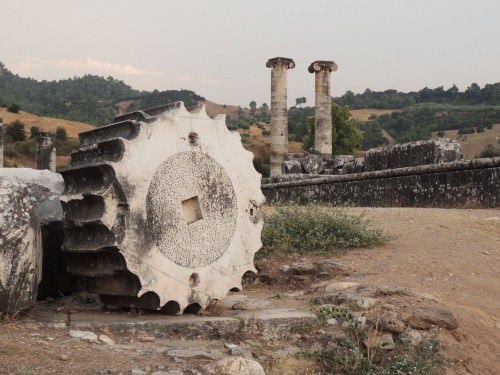
Column Drum with Flutes
Whilst some stone columns were carved in one piece, as buildings became bigger, columns began to be constructed from separate drums. These were individually carved and fitted together using a wooden dowel or metal peg in the centre of the drum. Columns made from individual drums are remarkably resistant to seismic activity. The elasticity provided by the possibility of fractional movements between drums means that the collapse of such columns is almost always due to other destructive forces such as high winds or weakening of the building through the removal of stone elements for re-use elsewhere, rather than earthquakes. Despite this advantage though, the Romans preferred single monolithic shafts for their columns. The Romans also standardised column production from the 1st century BCE, preferring the ratio of 6:5. That is the height of the column shaft was five-sixths of the total height of the column with its base and capital. Celebrated examples of this type of column may be seen in the Pantheon of Rome.
THE ARCHITECTURAL ORDERS
The evolution of columns in the ancient world has been classified within architectural orders. The three principal orders are Doric, Ionic, and Corinthian. First though, we may place Egyptian columns which stood on a base and carried sculpted decoration of leaves on the column shaft and Persian columns which often had animal figures such as bulls as their capitals. In the Greek world the first order was Doric whose columns were wider at the bottom and had a simple capital but no base. Ionic columns stand on a base and have a capital in the form of a double scroll (volute). Corinthian columns are usually slimmer and taller, stand on a base and have a richly decorated capital, usually with sculpted flower and leaf decoration. These three all have vertical fluted carving. The Romans introduced the Tuscan column which had no flutes and a simple base and capital.Roman Doric columns were similar but with flutes. Composite columns appeared which mixed elements of the previous styles and finally, there were Solomonic columns with a twisted shaft.

Column Capital, Persepolis
Columns also incorporated geometric refinements in order to overcome some of the problems of optical illusion in large buildings. This is that actually straight lines seem to be curved when viewed from a distance. Therefore, columns often inclined slightly inwards as they rose, corner columns were slightly fatter and each column bulged slightly in the middle ( entasis ) all in order for the building to appear perfectly straight. The most famous example of these techniques is undoubtedly the Parthenon on the Athenian acropolis.
FREE-STANDING COLUMNS
Columns became so much a part of the aesthetic look of a building that the columns themselves began to become independent artistic elements. The bull-man columns of Persepolis and the Caryatids of the Erechtheion in Athens in the 5th century BCE are celebrated as works of art in their own right, independent of the structures they were originally designed to support.
Perhaps the most famous free-standing columns are the Ionic Naxian Sphinx column at Delphi (560 BCE) which was 10m high and Trajan ’s Column in Rome (113 CE) which stood over 30 metres high. Nearly 200 m of continuous frieze spiral around the column depicting over 2,500 figures illustrating the emperor's campaign victories in Dacia. The column was also originally topped by a statue of the emperor himself.
Commodus › Who Was
Definition and Origins
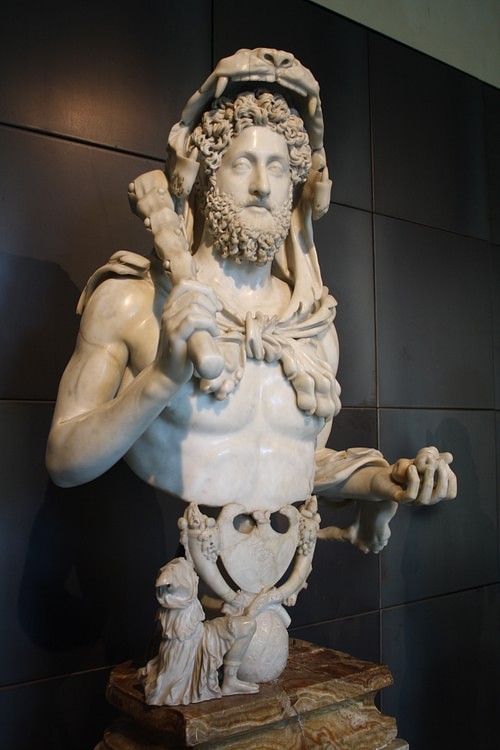
Commodus was Roman emperor from 180 to 192 CE. With the death of Roman Emperor Marcus Aurelius in March of 180 CE, the long reign of the five good emperors came to an end and with it so did the Pax Romana (the Roman Peace). Those emperors who followed for the next century would witness a time of both chaos and decline. The first of these inept emperors was Commodus, the son of Marcus Aurelius, who, according to most historians, was not only debauched and corrupt but also a megalomaniac, seeing himself as the reincarnation of the Greek god Hercules.
EARLY LIFE
Lucius Aurelius Commodus was born to the philosopher/king and Faustina the Younger at Lanuvium, a city fourteen miles southeast of Rome on August 31, 161 CE. He was the tenth of fourteen children and the only son to survive - his twin brother Titus Aurelius Fulvus Antonius died at the age of four. He would be the first emperor born while his father was the emperor and the last to inherit the throne as the previous five emperors (including Marcus) had obtained the throne through adoption.
COMMODUS AS EMPEROR
It did not take long for the future emperor to become a disappointment to his father for although he enjoyed the benefits of a quality education, Commodus inherited none of his father's work ethic and would find government life tedious and some believed this gave evidence that he was illegitimate, owing to his mother's supposed affairs. After serving alongside Marcus in battle on the northern frontier in 178 and 179 CE, Commodus returned to Rome in 180 CE after his father's death (he was only eighteen) and negotiated a peace settlement, a peace surprisingly favorable to Rome. Eventually, he would leave the reins of power in the hands of others while he devoted his time to worldly pleasures. One of the first to assume some of the emperor's responsibility was Saoterus whose relationship with Commodus would soon incur the ire of those in both the Senate and imperial household.
EVENTUALLY, COMMODUS WOULD LEAVE THE REINS OF POWER IN THE HANDS OF OTHERS WHILE HE DEVOTED HIS TIME TO WORLDLY PLEASURES.
Although Commodus considered his twelve-year-reign a new “golden age,” his lack of concern for political matters together with his life of leisure and extreme paranoia brought about what others might consider a reign of terror. Historian Cassius Dio, who called it the kingdom of “iron and rust,” wrote, “This man was not naturally wicked, but, on the contrary, as guileless as any man that ever lived. His great simplicity, however, together with his cowardice, missed the better life and then was led on into lustful and cruel habits, which soon became second nature.” Because he relied on others to rule in his place, those around him realized that he could be easily manipulated, allowing for a number of conspiracies against his life to develop - one was even initiated by his older sister Lucilla and a number of senators in 182 CE.
Lucilla believed she and her husband Lucius Verus had been passed over by Marcus Aurelius as potential heirs to the throne.The plot was simple enough: Claudius Pompeianus Quintianus, her nephew, was to lie in wait until the emperor entered the Colosseum and then stab him; however, the assassination was bungled when Quintianus raised his dagger and instead of quickly stabbing Commodus he shouted “This is what the senate has sent you.” Before he could complete his sentence, he was seized by the Praetorian Guard. This foiled attempt upon his life, together with the recent death of the emperor's trusted chamberlain Saoterus, caused Commodus to take decisive action - those implicated in the plot were all executed. Contrary to some authors, Lucilla was not immediately executed; instead, she was exiled and executed much later. Commodus also took the opportunity to execute Paternus, the commander of the Praetorian Guard, who had been implicated in both Saoterus' assassination as well as Lucilla's plot.
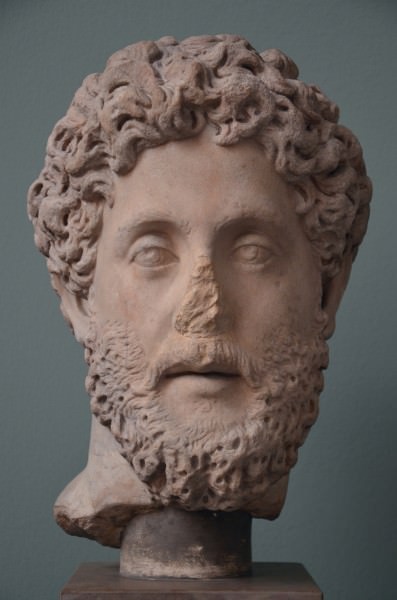
Roman Emperor Commodus
During this traumatic time in Commodus's life, Tigidius Perennis, who had served as the joint commander of the Praetorian Guard with Paternus, seized the opportunity and began to get closer to the vulnerable emperor, assuming considerable governmental power, something that allowed Commodus to pursue other interests. After his sister's plot, the emperor refused to appear in public and all communication went through the new chamberlain. Perennis took his new role seriously and proved to be both brutal and efficient, eliminating any rivals to his authority while making numerous enemies along the way. As he amassed great wealth and Commodus pulled further away from governmental responsibilities, he began to believe himself to the true emperor, not Commodus, even going so far as to plot to do away with the emperor and prepare his own sons for succession. Herodian, in his History of the Roman Empire, wrote, “Perennis assumed full personal charge of the empire, driven by his insatiable lust for money, his contempt for what he had, and his greedy longing for what was not yet his.” Unfortunately, he had made one enemy, the former slave and member of the imperial household, Cleander, who would bring him to ruin. In 185 CE, through a group of 1500 soldiers returning from Britain, Cleander leaked information to Commodus of Perennis's plot to overthrow him and assume power - Perennis's execution (and that of his sons) was immediately ordered.
Cleander stepped in as the emperor's new chamberlain, and as with Perennis, Commodus was freed to return to his life of pleasure, and as with his predecessor, Cleander destroyed all opposition. Everything was for sale - senatorial seats as well as governorships, and, of course, a portion of the money went to Commodus. However, like Perennis, Cleander would not remain for long. In 190 CE a grain supply shortage would bring him down. The grain commissioner, Papeirius Dionysius, cut off all grain to the populace, blaming Cleander and his greed - Cleander has supposedly bought all the grain. The people were incensed and a few days later, while gathered at the Circus Maximus, a riot erupted. The people cried for the head of Cleander and they marched through the streets to the emperor's residence at the Villa of the Quintilli. Commodus feared for his life and when attempts to quell the mob failed, Commodus gave them what they wanted - the head of Cleander which was placed on a pole and marched through the street of Rome. Afterwards, Commodus realized that he would have to take over the reins of government himself.

Commodus As Hercules
COMMODUS AS HERCULES
A new Commodus emerged, one that saw himself as a reborn Hercules who appeared in public wearing a cloak made out of the hide of a lion over his head (a reference to the Nemean Lion of Hercules's Twelve Labors). The Senate was even made to declare him a living god. Herodian wrote, “First he discarded his family name and issued orders that he was to be called not Commodus, son of Marcus, but Hercules, son of Zeus. Abandoning the Roman and imperial mode of dress, he donned the lion skin, and carried the club of Hercules. … He erected statues of himself throughout the city …. for he wished even his statues to inspire fear of him.” Next, he renamed the twelve months, and after a fire in 191 CE destroyed much of the city (including the Temple of Peace and Temple of Vesta ) he seized the opportunity to completely rebuild Rome. Because he considered himself the new founder, he renamed Rome Colonia Lucia Annia Commodiana; the people became known as Commodiani. To the surprise of everyone, he even took part in gladiatorial contests, fighting against the physically handicapped and an array of beasts from a raised platform which included a tiger, an elephant and even a hippo.
DEATH
When he decided to fight in the arena on New Year's Day in 193 CE to celebrate the city's rebirth, his mistress Marcia (his wife Bruttia Crispina had been banished and executed in 191 CE) as well as his new chamberlain (Electus) and new commander of the Praetorian Guard (Quintas Aemilius Laetus) realized he had gone too far. After they failed to talk him out of his ridiculous plans, he became incensed and threatened to add their names to a long list of people he wanted executed. Later, as usual, Marcia brought Commodus a glass of wine prior to his bath; however, this time it was laced with poison. When the poison failed, Commodus's fitness coach, Narcissus (a professional wrestler by trade) entered and choked him to death. Although many wanted to drag his body through the streets of Rome, Pertinax (who oddly enough would succeed Commodus) seized the body, prevented its desecration and, finally, Commodus was laid to rest in Hadrian ’s Mausoleum.
The Magical Lullaby of Ancient Egypt › Origins
Ancient Civilizations
The Magical Lullaby (popularly known as Charm for the Protection of a Child ) is an inscription from the 16th or 17th century BCE. The poem exemplifies the ancient Egyptian's personal religious and spiritual practices as it is a spell which was sung to ward ghosts away from sleeping children. Magic (known as heka by the Egyptians after their god of the same name) was a common aspect of daily life and religious and medical practices in ancient Egypt. The Magical Lullaby is one example of the kind of spell which everyday people would use for protection. According to historian Margaret Bunson:
Three basic elements were always involved in the practice of heka : the spell, the ritual, and the magician. Spells were traditional but also changed with the times and contained words which were viewed as powerful weapons in the hands of the learned. (154)
Most people, however, were not 'magicians' and could not even read, and so certain spells were memorized by hearing and passed down generation to generation. The Magical Lullaby seems to be one such spell which could be sung by lay people for protection regularly without them having to consult with a priest, seer, or doctor.
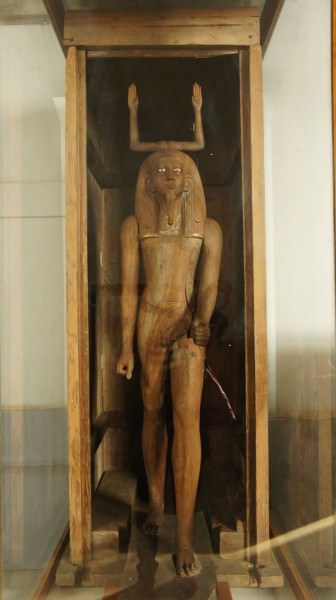
Heka
MAGIC IN ANCIENT EGYPT
Magic was an integral part of the lives of ancient Egyptians. Magic, in fact, created and sustained the world. In the Coffin Texts(written c. 2134-2040 BCE) the god Heka states that he existed before the gods. He was the god of magic and the magic itself, the creative energy which enabled the creative act. Heka had always existed, would always exist, and informed every aspect of the Egyptians' lives. What one would consider 'supernatural forces' in the modern day were completely natural to them.
The gods and goddesses made regular and expected appearances daily, evil spirits and the angry dead needed to be guarded against, and even the most commonplace aspects of one's life, such as trees, brooks, rocks, and hills were imbued with a spiritual element. The rising and setting of the sun were events the ancient Egyptians believed they played a significant part in as they performed ceremonies to keep the serpent Apophis from destroying the boat of the sun god Ra and plunging the universe into chaos. Bunson notes how, "magic was the binding force between the earth and other worlds, the link between mortals and the divine" (154). Spells and rituals were used routinely for the most serious or mundane situations one encountered. Egyptologist James Henry Breasted comments on this, writing :
The belief in magic penetrated the whole substance of [ancient Egyptian] life, dominating popular custom and constantly appearing in the simplest acts of the daily household routine, as much a matter of course as sleep or the preparation of food. (200)
A priest, magician, physician, or seer who had acquired a certain amount of power and knowledge, was usually called upon in cases of illness, to interpret dreams, to mediate a dispute between the living and an angry spirit, or as mediator between human beings and the gods. Magic was evident in all the stories concerning the gods, and since human beings were considered co-workers with the deities, it made sense that the magical element was available to the people as it was to their gods. Egyptologist Rosalie David writes:
It was believed that society consisted of four groups - gods, the king, the blessed dead, and humanity - who shared certain moral obligations and a duty to interact in order to maintain world order. (271)
Part of the maintenance of the world, naturally, was one's health and well-being. Although the gods were always watching over one, it was clear their responsibilities were great and humans needed to do their own part to help protect themselves by regularly calling attention to themselves and their needs; and so magical charms, amulets, household statues, and incantations were regularly employed to drive away evil spirits or ghosts and keep the home safe. Egyptologist WM Flinders Petrie writes:
Children especially wore figures of Bes, and less commonly Taweret, the protecting genii of childhood...The household amulets in the prehistoric days were the great serpent stones with figures of the coiled serpent...in later times the image of Horus subduing the powers of evil seems to have been the protective figure of the house. (23)
Although Bes, Taweret, Horus, and many other deities offered protection, all of the gods and goddesses had their own special sphere of expertise. When one wished for help in love one called upon Hathor, for wisdom one would consult Neith, Thothwould assist one in writing, Ptah would dispense justice, and likewise, there was a god who specialized in protection through healing.
DOCTORS AS MAGICIANS
Heka was not only the god of magic but also of medicine. He is depicted as a man carrying a staff and knife and ancient Egyptian doctors were called Priests of Heka. Magic was as integral a part of medical practice in ancient Egypt as any other aspect of life, and so Heka became an important deity for doctors. He was said to have killed two serpents and entwined them on a staff as a symbol of his power; this symbol of the medical arts passed to the Greeks and on to the present day. One sees the symbol of Heka in modified form, now known as the caduceus, regularly in doctor's offices as the symbol of Hippocrates, father of medicine.

Caduceus
A papyrus dated to the reign of Amenhotep I (c. 1541-1520 BCE), now known as the Ebers Papyrus, is among the oldest medical texts in the world. It lists over 700 diagnoses and prescriptions with chapters on skin ailments, fractures, burns, digestive problems, as well as more serious conditions such as cancer and heart disease. This work demonstrates a high degree of medical knowledge and skill, and with another, the so-called London Medical Papyrus (c. 1629 BCE), also shows how magic and medicine were considered the same art. Another medical text, the Edwin Smith Papyrus (c. 1600 BCE), although offering primarily practical medical advice, also contains spells for healing.
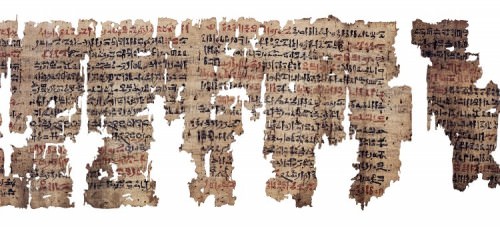
The London Medical Papyrus
Doctors could be expensive, however, or were simply unavailable and the gods, as noted, were very busy so the common people of Egypt became their own magicians and doctors when they had to. Egyptologist Joyce Tyldesley writes:
The high levels of infant mortality meant that childhood illnesses were always worrying times for the mother. Very few parents could afford to take their sick children to consult doctors [and so] not surprisingly, mothers turned again to folk wisdom and magic to protect their darlings, placing their trust in a variety of charms, amulets, and spells. (79)
Illness in ancient Egypt, no matter one's age, was attributed either to the gods (who were punishing one for sins or teaching one a lesson), the dead (who were upset over some wrong done them in life or improper burial rites), or evil spirits who preyed on the unsuspecting and, especially, the innocent children. The Magical Lullaby is generally interpreted to address ghosts, rather than only evil spirits, as understood through the reference to them appearing in disguise (the lines, "who enterest in stealth, his nose behind him...who enterest in stealth, her nose behind her..."). This interpretation is challenged, however, and the lines are also interpreted to apply to evil spirits in general, not only disembodied ghosts of those who were once mortal.
THE TEXT
The poem is a short verse which speaks directly to the spirits who meant the child harm and warn of the weapons the speaker has for defense. The lines themselves, the spell, would be the 'weapon' in that it would scare the ghost away from the child but the variety of foods and spices mentioned were also potent defenses. Bunson comments on the work:
The Magical Lullaby is a charming song from ancient Egypt crooned by mothers over their children's beds. The lullaby was intended to warn evil spirits and ghosts from tarrying or planning harm. The mother sang about the items that she possessed in order to harm the spirits of the dead. She carried lettuce to 'prick' the ghosts, garlic to 'bring them harm', and honey which was considered 'poison to the dead.' (154)
The following translation comes from Development of Religion and Thought in Ancient Egypt by James Henry Breasted. The 'Efet-herb' mentioned is understood to be lettuce:
Run out, thou who comest in darkness, who enterest in stealth, his nose behind him, his face turned backward, who loses that for which he came.Run out, thou who comest in darkness, who enterest in stealth, her nose behind her, her face turned backward, who loses that for which she came.Comest thou to kiss this child? I will not let thee kiss him.Comest thou to soothe him? I will not let thee soothe him.Comest thou to harm him? I will not let thee harm him.Comest thou to take him away? I will not let thee take him away from me.I have made his protection against thee out of Efet-herb, it makes pain; out of onions, which harm thee; out of honey which is sweet to living men and bitter to those who are yonder (ie the dead); out of the evil parts of the Ebdu-fish out of the jaw of the meret; out of the backbone of the perch. (201)
COMMENTARY
The song is thought to have been sung fairly regularly by mothers, older sisters, and nurses throughout Egypt. Although it was obviously eventually written down, it may predate the 16th-17th century BCE and passed down through oral transmission, although this is speculation. Throughout the piece the speaker directly addresses the spirit who could be invisibly entering the home and, it was thought, drives it away.
THE MAGICAL LULLABY IS THOUGHT TO HAVE BEEN SUNG FAIRLY REGULARLY BY MOTHERS, OLDER SISTERS, & NURSES THROUGHOUT EGYPT OR TUCKED INTO AN AMULET ONE WOULD WEAR.
According to scholar Andre Dollinger, the speaker would need to address both male and female spirits in the opening line because "magic spells are in some way akin to legal writings: they are effective only against those against whom they are specifically applied. Using only the male form in a curse would leave the child open to attacks from female demons" (1).Dollinger further clarifies the lines, "Comest thou to kiss this child...Comest thou to soothe this child" as referring to ghosts which might appear friendly, even helpful, but are only really coming to harm the child. After making clear that the spirit will not get what he or she came for, the speaker threatens the ghost with the weapons at hand: lettuce, onions, honey, and the guts of fish.
The edibles mentioned suggest to some scholars (Breasted among the first) that the child may have been fed lettuce, onions, and honey with some fish as a preventative against possession. The reference to honey as sweet to the living but bitter to the dead is one of the lines scholars point to in interpreting the song as defense against ghosts, not evil spirits. Honey was considered bitter after death during some periods in Egyptian history. The line regarding the fish is interpreted in the same way.The Egyptians, especially of the lower classes, ate fish regularly but discarded the insides (the 'evil parts') as distasteful; the dead were thought to feel the same way.
Breasted's conclusion that the song actually relates a recipe which the child would eat makes sense, but it has also been suggested that these ingredients may have been mixed in a paste and applied to doorways and windows. Whether one actually made this mixture may not have mattered, however; perhaps just singing the song was enough to drive the ghosts away and keep one's child safe. Tyldesley writes:
These spells were known to be so effective that they were frequently written on a small scrap of papyrus packed into a specially carved wooden or gold bead and carefully suspended around the neck of the beloved child to ensure maximum protection. (80)
The popularity of such spells attests to the belief in their importance and the vital relationship the people had with the unseen world. The ancient Egyptians believed in a universe alive with supernatural possibilities. From tomb inscriptions to letters to stele to literature to the more obvious examples of charms and spells, it is clear that they saw the world imbued with spiritual forces of enormous power.
Although there were authority figures such as priests and seers who could advise them on how to navigate this world, they understood they also had to take personal responsibility for their lives, those of the larger community, and the maintenance of order and balance in the universe. The Magical Lullaby, sung by a caregiver to a child or tucked into an amulet one would wear, is an intimate glimpse into this grand vision of one of the greatest civilizations of the ancient world.
LICENSE
Article based on information obtained from these sources:with permission from the Website Ancient History Encyclopedia
Content is available under License Creative Commons: Attribution-NonCommercial-ShareAlike 3.0 Unported. CC-BY-NC-SA License